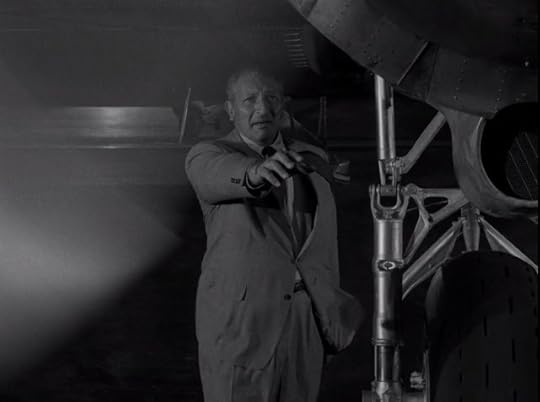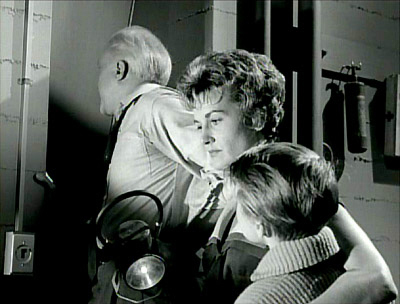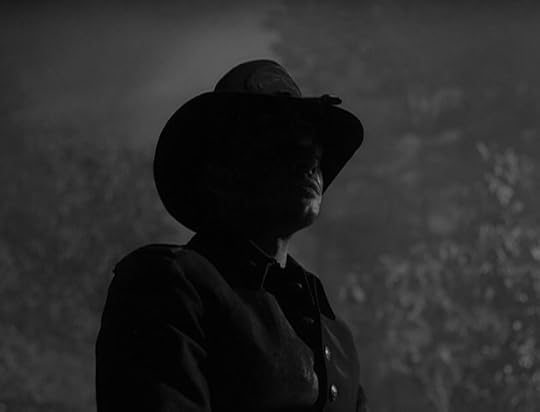August 29, 2024: Our Twilight rewatch continues with season 3, episodes 1-4!
Season 3, Episode 1, “Two”
This episode first aired February 15, 1961.
The episode was shot on the long-neglected Hal Roach Studios in Culver City that were previously used for production on the 1930’s The LIttle Rascals series.
Writer-director Montgomery Pittman wanted to cast his step daughter, Sherry Jackson, as the woman, but network executives felt she was too young at 19 and preferred Elizabeth Montgomery who was 29 at the time.
Montgomery only utters a single word of dialogue in this episode, “Pekrasny”, which means “pretty” in Russian.
The far futuristic barbershop in the ruined city advertized a hairtcut for a whopping $5, which was roughly four times the price of what you’d have paid back in 1961.
Director Montgomery Pittman started his career as an actor before transition to writing and directing. He wrote and directed two more episodes of the series, season 3’s “The Grave” and season 4’s “The Last Rites of Jeff Myrtleback”. He died of cancer less than a year after this episode aired.
Actress Elizabeth Montgomery was a distant cousin of axe murderer Lizzie Borden. She is no doubt best remembered for her portayal of Samantha Stephens in Bewitched (1964). Her husband and the show’s director, William Asher, noted that she would twitch her upper lip when nervous, giving the impression that she was wiggling her nose – so they used it as a spellcasting conceit in the series. At the conclusion of the show’s eighth season, Montgomery fell in love with the show’s script supervisor and divorced Asher, thereby dooming a ninth season pick-up. A nine foot tall bronze statue of Montgomery riding a broomstick sidesaddle can be found in Salem, Massachussetts.
Reflecting back on her Twilight Zone experience, Montgomery noted: ”Making this episode was creepy. I couldn’t help thinking what it would be like if I went around the cocrner and there actually wasn’t anyone there – nothing but rubble, grass growing in the street, the debris of a dead human race.”
Charles Bronson, who played the man, changed his name from Buchinsky to Bronson during the Red Scare of the 1950’s, naming himself after the Bronson Gate at Paramount Studios. He built a career playing the strong silent types in movies like The Magnificent Seven (1960), The Great Escape (1963), and The Dirty Dozen (1967). His portrayal of the claustrophobic tunnel rat Danny Velinsk in The Great Escape was modeled after his own experience working the coal mines with his father.
Bronson worked overseas in the late 60’s, starring in several international westerns. Sergio Leone once called him “the greatest actor I ever worked with”. Returning to the U.S., made his mark in some notable urban thrillers such as The Mechanic (1972), The Stone Killer (1973), Mr. Majestyk (1974), and perhaps his most famous role in Death Wish (1974) at the age of 53, a part he got because the original actor considered, Henry Fonda, was so disgusted with the script he turned it down.
Bronson enjoyed a busy career throughout the 80’s and 90’s. Among the roles he was considered for were leads in Walter Hill’s The Driver (1978), Superman (1978), Escape from New York (1981), and Die Hard (1988). According to Billy Crystal, he was offered the role of Curly in City Slickers (1991), but rudely turned it down after learning the character died. Jack Palance, who ended up getting the role, earned an Oscar for his performance.
Bronson was a private man who rarely did interviews. He suffered from Alzheimer’s late in life and passed away in 2003. One of the best Charles Bronson stories comes from Kurt Russell who worked with him when Russell was just a kid. After finding out that it was Bronson’s birthday, young Russell gave him a present. The older actor took it and walked away without saying a word. Later, Russell was called to Bronson’s office where an emotional Bronson confided that he reacted the way he did because it was the first time anyone had ever given him a birthday present. Bronson ended up reciprocating by gifting Russell a skateboard for his birthday, and even got a matching one for himself. But later during production, Bronson noticed that Russell wasn’t using the skateboard. He asked why and Kurt told him that he was told he wasn’t allowed to skateboard on the lot. Incensed, Bronson grabbed both their skateboards and, Russell in tow, marched into the office of the head of the studio and informed him they would be skateboarding around the lot.
A solid start to season 3. Bronson is fantastic but Mongomery – boy, she is an world all her own. I had a huge crush on her during her Bewitched days and she is nothing short of drop-dead-gorgeous in this episode – with the acting chops to match. Didn’t love the pew-pew energy beams from the rifle, or the 5-year-old canned chicken drumsticks, but they were minor quibbles in an otherwise satisfying episode.
P.S. She looked better in that military uniform than the dress.
Season 3, Episode 2, “The Arrival”
This episode first aired September 22, 1961.
The script was originally titled “DC-3”.
The exterior shots and hangar scenes were filmed at Santa Monica Airport while the rest of the scenes were filmed on an MGM sound stage.
The scene in which the Grant Sheckly character approaches the rotating propellor blade was eerily prescient. Episode director Boris Sagal was killed twenty years later when he accidentally walked into a helicopter’s rear rotor blade. After returning from filming aerial shots for the movie World War III (1982), he turned the wrong way, apparently preoccupied with his work, and suffered devastating head and shoulder injuries. Production resumed the next day with a new director.
Actor Fredd Wayne, who played Paul Malloy, had previously appeared as Barney Kaemener in “Twenty-Two”.
Noah Keen, who plauyed Bengston, would return later the same season for an appearance in “The Trade-Ins”.
This one was reminiscent of season 1’s “A World of Difference” minus the clever twist and thought-provoking ambiguity. The classic “It was all a dream” conceit devoid of nuance doesn’t exactly make for compelling viewing. Not a Top 10 pick.
Season 3, Episode 3, “The Shelter”
This episode first aired September 29, 1961.
Reflecting back on this episode, Rod Serling said: “For seemingly realistic reasons, it’s my feeling now that if we survive, what do we survive for? What kind of world do we go into? You know, if it’s rubble, poisoned water, and inedible food, and my kids have to live like wild beasts, I’m not partiucialry sure I want to surivve in that kind of world.”
A week after this episode aired, President John F. Kennedy advised Americans to build bomb shelters to protect themselves from possible atomic fallout in the event of a nuclear exchange.
Early in the episode, all the t.v. and radio stations go to static and citizens are directed to the CONELRAD stations. The Control of Electromagnetic Radiation was a Civil Defense radio station that would broadcast official instructions and information in the event of a national emergency. It was eventually replaced by the Emergency Broadcast System which was, in turn, replaced by the Emergency Alert System.
The voice of the emergency broadcast announcer belonged to actor James Coburn.
Late in the episode, while trying to gain access to the bomb shelter, one of the characters suggests heading over to Bennett Avenue for a pipe they can use as a battering ram. Bennett Avenue was the street in New York where Rod Serling grew up.
This episode sparked a fair audience response. According to Serling: “We had 1,300 letters and cards inside of two days. I think we hit some kind of nerve.”
“The Shelter” inspired an episode of Happy Days (1974) in which the Cunninghams’ plans to build a bomb shelter in their backyard are complicated by friends wanting to know if they will be included when the time comes. It also inspired The Simpsons episode “Bart’s Comet” which saw almost all of Springield squeeze into Homer’s bomb shelter.
This was the first of the eight Twilight Zone episodes Lamont Johnson would direct and, from the sounds of it, probably wasn’t his favorite: “I found the script a little preachy, but I just got throughly involved with the actors – Jack Albertson was a joy to work with. It was just a question of working on the characters of these wonderful charactor actors, and getting as much out of them as possible, which saved it to a degree.”
Larry Gates, who played Dr. Bill Stockton, broke out late in life, kicking off a successful Broadway career in his early 40’s. He received a Tony nomination for his work on stage as well as a Daytime Emmy award for his portrayal of H.B. Lewis on The Guilding Light, a role he played until his death. Gates reflected back on this episode: “We had a wonderful cast and an excellent director, a happy company and crew and a fascinating script. When I saw the episodes years later, I didn’t like my performance. I thought I had overacted. But the script, direction, and cast made it work.”
Jack Albertson, who played Jerry Harlowe, was a former vaudeville performer-turned-actor perhaps best known for his portrayal of The Man in Chico and the Man (1974). He won an Best Supporting Actor Oscar for The Subject Was Roses (1968) and was one of only 9 actors to score the coveted Triple Crown of Acting: Tony, Emmy, and Oscar. He would make a reappearance in season 4’s “I Dream of Genie”.
Peggy Stewart, who played Grace Stockton, was signed by Republic Pictures early in her career where she made westerns and serials. Over the course of three years, she starred in over 30 films, most of them westerns, but she grew tired of the genre and ended up leaving the film business in 1953 in favor of television work. In this episode, it’s very clear that her character is a tribute to America’s Mom, Barbara Billingsley’s June Cleaver from Leave It To Beaver (1957), from her mannerisms and delivery to her hairstyle and clothing.
Sandy Kenyon, who played Frank Henderson, previously played flight navigator Magellan in “The Odyssey of Flight 33”.
Michael Burns, who played young Paul Stockton (and did, I thought a terrific job for a boy his age), is a former child actor who went on to establish a distinguished career as a historian, writer, and college professor. He was, at one point, considered for a role as one of the band members on The Monkees (1965).
This is one of the higher rated season 3 episodes and while I liked the idea, it played to me like a less provocative, more heavy-handed “The Monsters Are Due on Maple Street”. Also, there were a few instances that left me scratching my head – like the fact that satellites were mistaken for incoming missiles in the first place, and then took half an hour to check out. And when the neighbors are arguing about the fact there is so little room in the bomb shelter and which family to save my initial thought was: “Uh, what about just the kids?”. I mean, wouldn’t that be the no-brainer decision?
All in all, a fine episode but, surprisngly, not one I think will be making my season 3 Top 10 list. But I guess we’ll see how the rest of the season pans out.
Season 3, Episode 4, “The Passerby”
This episode was first broadcast October 5, 1961.
The episode aired 100 years after the start of the Civil War.
This episode was a spin on a script titled “The Cause” that Serling had previously written for Matinee Theatre and aired in 1958. It told the story of a soldier returning from the Civil War who encounters a woman seeking to reclaim her land. Despite the fact that they supported opposing sides of the conflict, they fall in love. But when the woman’s relative pays a visit, she is forced to choose between her family and the man she loves.
The episode’s twist ending inspired an episode of MASH (1972) in which a feverish Corporal Klinger converses with a Private Westin who ends up walking down a road similar to the one walked by the soldiers in this episode. Coincidentally, actor Jamie Farr who played Klinger puts in an uncredited appearance at the beginning of this episode as the soldier who stagggers by, his face partially covered.
This episode was directed by Elliot Silverstein who previously directed the season 2 finale, “The Obsolete Man”. Silverstein, recalled: “James Gregory provides an example of the kind of tension you’re under. He suggested that since he was dead, he should wear his buckle upside down, and I said “Fine, fine.” What he didn’t know is that I was never going to see it. I didn’t care, and I just wnated to get on to the next shot.” (P.S. I’m not sure how an upside-down belt buckle would look like anything else than a wardrobe mistake).
Actor James Gregory, who played the strumming Confederate Sergeant, left his career as a stockbroker to pursue acting. He starred on stage and screen, amassing well over one hundred film and t.v. credits by the time he retired in 1993. He is perhaps best remembered as the bellicose Inspector Luger from the t.v. series Barney Miller (1975).
Joanne Linville, who played Lavinia Godwin, enjoyed a steady career in t.v. supporting roles during the 50’s and 60’s. Genre fans may recognize her as the first female romulan to appear on screen in “The Enterprise Incident”. Linville reflected back fondly on her time on the show: “When I played the role of Lavinia, I was thinking to myself “This is what it was like to be an actress on the set of Gone with the Wind. I was going so much television at the time, but usually I stood about and helped someone break jail or played patient in bed. On the Twiligh Zone, I was the lead. Well, James Gregory played the lead. We both played the lead. But my role was so much larger than most of the hundred television shows I did. I recall my role was much larger on Alfred Hitchcock and Star Trek, but thse were the days where you took what you could get and be thankful for the oppportuity to act.”
I actually quite liked this one. Surprising since I haven’t really been a fan of the period episodes to date. Even though you know where it is headed, it plays out nicely, and the revelation that she is dead too took me by surprise. Loved the scene and shot composition of that Union shoulder on horseback who pays them a visit. I could have done without the Abraham Lincoln cameo at the end, but otherwise an enjoyable episode that will probably make the back half of my Season 3 Top 10.
The post August 29, 2024: Our Twilight rewatch continues with season 3, episodes 1-4! appeared first on Joseph Mallozzi's Weblog.
Joseph Mallozzi's Blog
- Joseph Mallozzi's profile
- 39 followers







